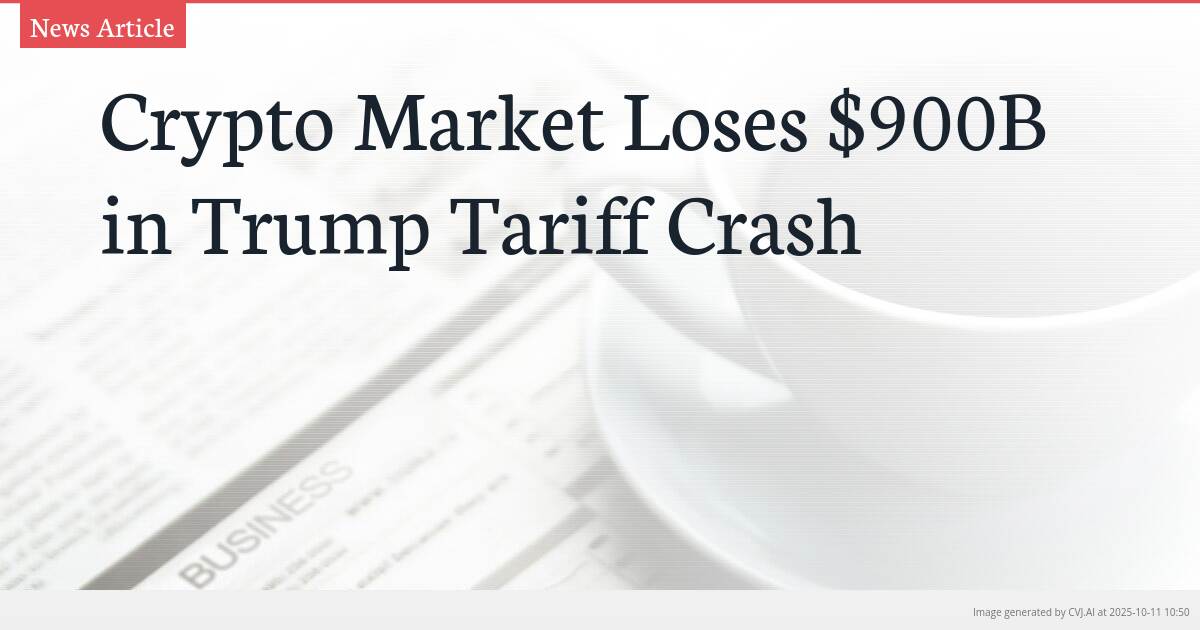This summary text is fully AI-generated and may therefore contain errors or be incomplete.
Introduction
The cryptocurrency market experienced its largest liquidation event in history after President Trump’s tariff announcement triggered a massive sell-off, wiping out nearly $900 billion in market capitalization within 12 hours. The dramatic plunge from $4.12 trillion to $3.3 trillion on TradingView erased months of gains before a partial recovery to $3.67 trillion, leaving traders divided on whether this represents a buying opportunity or the start of a prolonged downturn.
Key Points
- A single Bitcoin whale earned $200 million by opening and closing short positions around the market crash
- Analysts believe markets were 'looking for a catalyst' to correct due to record leverage levels
- The crash represents the largest single liquidation event in cryptocurrency market history
The Perfect Storm: Trump Tariffs and Excessive Leverage
The catalyst for the historic market collapse came from an unexpected source: US President Donald Trump. In what market observers described as a ‘deja vu’ moment, the President alleged Chinese deception and threatened new tariffs on Friday, triggering the first wave of market-wide declines. The announcement became official hours later, confirming that these tariffs would begin on November 1, sending shockwaves through both traditional and cryptocurrency markets.
However, according to analysis from The Kobeissi Letter, markets were already ‘LOOKING for a catalyst to pull back’ given the massive amount of leverage, particularly in cryptocurrency. The analysis noted that leverage was ‘through the roof’ and the S&P 500 hadn’t seen a 2%+ decline in six months, creating conditions ripe for a significant correction. President Trump’s tariff announcement provided the perfect excuse for markets to unwind excessive positions that had built up during months of steady gains.
Whale Movements and Structural Unwinding
While retail investors suffered massive liquidations, some sophisticated traders positioned themselves perfectly for the downturn. Bull Theory reported that one of Bitcoin’s oldest wallets appeared to anticipate the market move, opening substantial short positions on both BTC and ETH a day before Trump’s announcement. The mysterious entity doubled down as events unfolded and ultimately closed all shorts with a profit of approximately $200 million in just 24 hours.
Unlike previous market dumps that were often retail-driven, Bull Theory characterized this collapse as ‘structural,’ suggesting that ‘a fund or a desk was forced to unwind positions all at once.’ This institutional-scale unwinding contributed to the velocity and severity of the decline, creating what became the single-largest liquidation event in digital asset market history. The coordinated nature of the selling pressure indicated that this was no ordinary correction but rather a systemic flush of leveraged positions.
Diverging Views on Market Recovery
The crypto community remains sharply divided on what comes next. The majority view, championed by prominent figures including CZ of Binance, suggests this represents a classic ‘buy-the-dip’ opportunity. CZ drew parallels to the COVID crash, when Bitcoin dumped to $4,000 only to explode in the following months. Bull Theory echoed this optimism, stating that ‘the whales already took their entry’ and ‘retail panic is peaking,’ which historically marks the beginning of the ‘next leg’ upward.
However, Crypto Bully presented a more cautious outlook, warning that unless Trump immediately reverses his tariff statements, this may not result in a V-shaped recovery. The analyst projected that ‘most alts with 50-70% wicks will bleed down and fill them or partially fill it before reversal,’ suggesting a more painful and prolonged downturn if the tariff threats materialize. This perspective acknowledges the fundamental economic impact that sustained trade tensions could have on risk assets.
Amid the price predictions, popular X user Cobie offered a different perspective focused on risk management. Cobie emphasized that such collapses serve as ‘a perfect example of why investors should avoid taking leveraged positions,’ which can ‘wipe out years of gains’ in moments. Instead, the recommendation is to focus on building a long-term portfolio by holding only assets with genuine utility and avoiding speculative tokens that chase hype without substance.
📎 Read the original article on cryptopotato.com

